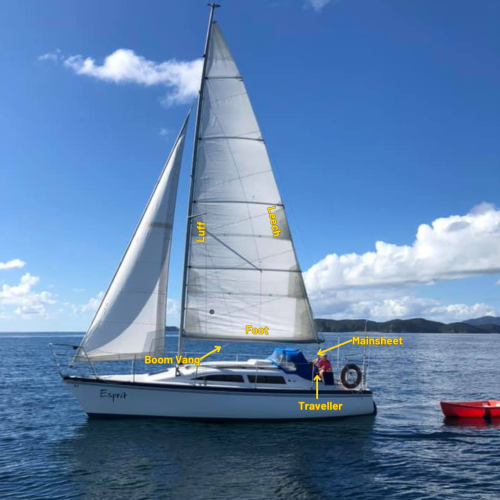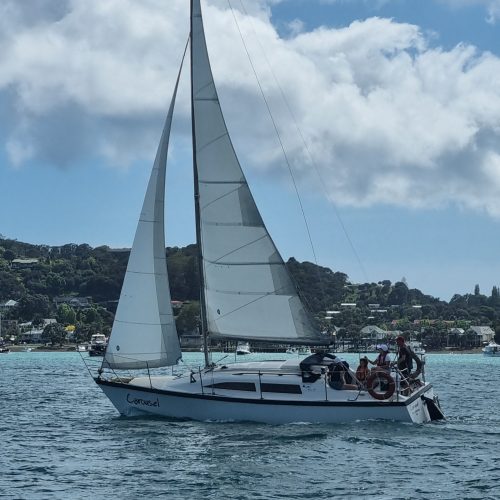We often coach with the guideline “a flappy sail is not a happy sail.” And this is good advice, however, this can lead to over-sheeting, i.e., trimming your sails in too tight, which increases weather helm, or the tendency of the boat to want to round up into the wind, making the boat more difficult to steer. In stronger winds it may make things more uncomfortable by causing the boat to heel too far. Trimming the mainsail effectively will reduce heel, minimise weather helm and decrease leeway. The result is more efficient and comfortable sailing, especially when sailing upwind. Get to know the main sail controls on your boat and experiment to see how to sail your boat effectively.
 You can use the mainsail leech tell tales to help guide your sheeting, ideally, they should stream horizontally most of the time.
You can use the mainsail leech tell tales to help guide your sheeting, ideally, they should stream horizontally most of the time.
Mainsheet
Main sheet tension affects every characteristic of the sail. More than any other control, sheet tension needs to change in wind velocity and sea state.
On a reach, the golden rule “when in doubt, let it out” applies. Ease the sail until it begins to luff and you see bubble or backwind along its leading edge. Trim just enough to stop luffing.
Off the wind, the mainsheet simply moves the sail in and out of the boat, changing the sail’s angle to the wind. Don’t be afraid to let the sail out until it is against the shrouds and spreaders.
On the wind, tightening the mainsheet tightens the leech of the sail, reducing twist and rounding up the back of the sail, which forces the boat up into the wind and makes it point. Easing the mainsheet opens the leech, inducing twist and accelerating the flow of air across the sail, which encourages the boat to bear off and accelerate. In more wind, the mainsheet can be trimmed tighter without causing a speed loss and pointing will improve. With less breeze, be careful not to over-trim or the boat won’t accelerate. Keep in mind another fundamental rule of sail trim: speed first, and then try to point. Start with the mainsheet relatively eased and gradually trim harder once the boat is up to speed.
Traveller
Traveller – in light to moderate winds use the traveller to keep the boom on the centre, in light winds with the mainsheet eased the car may have to be well to weather. The traveller should be constantly in motion upwind and used in concert with the helm as the boat sails through gusts and lulls.
 Boom Vang
Boom Vang
Boom vang – used to control the angle of the boom horizontally, particularly when the sail is eased out beyond the extension of the traveller. In this case where the mainsheet has no direct pull down on the mainsail it takes over as the primary control of twist.
Outhaul
Outhaul – controls depth in the lower third of the sail; flattening the foot, one of the lesser adjusted controls, it should be eased in lighter airs and brought on as the breeze increases.
Luff Tension
Haylard and/or Cunningham– controls the point of draft in the sail; as we begin to flatten our sail the point of maximum draft will begin to move aft in the sail away from its optimum design point; we can use the cunningham or halyard to tension the luff and pull the draft back forward.
More reading
There are loads of great resources online here are a couple we referenced for this blog;





